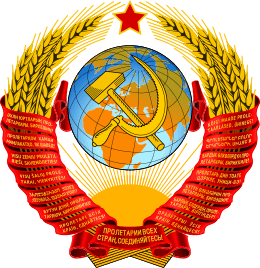Elections in the Soviet Union
The electoral system of the Soviet Union was based upon Chapter XI of the Constitution of the Soviet Union and by the Electoral Laws enacted in conformity with it. The Constitution and laws applied to elections in all Soviets, from the Supreme Soviet of the Soviet Union, the Union republics and autonomous republics, through to regions, districts and towns. Voting was theoretically secret and direct with universal suffrage.[1] However, in practice, until 1989 voters could only vote against the Communist Party candidate by using polling booths, whereas votes for the party could be cast simply by submitting a blank ballot.[2]
A 1945 decree allowed for members of the Red Army stationed outside the Soviet Union to vote for both chambers of the Supreme Soviet of the USSR (the Soviet of the Union and Soviet of Nationalities) in special 100,000-member districts. These were first enacted in the 1946 legislative elections and continued through the next decades as the Red Army continued its presence in the Eastern Bloc.[3]
See also
References
- Leonard Bertram Schapiro, The government and politics of the Soviet Union, Taylor & Francis, 1977, ISBN 0-09-131721-5
- Nohlen, D & Stöver, P (2010) Elections in Europe: A data handbook, p1642 ISBN 978-3-8329-5609-7
- The Distinctiveness of Soviet Law. Ferdinand Joseph Maria Feldbrugge, ed. Martinus Nijhoff Publishers: Dordrecht (1987): 112.
